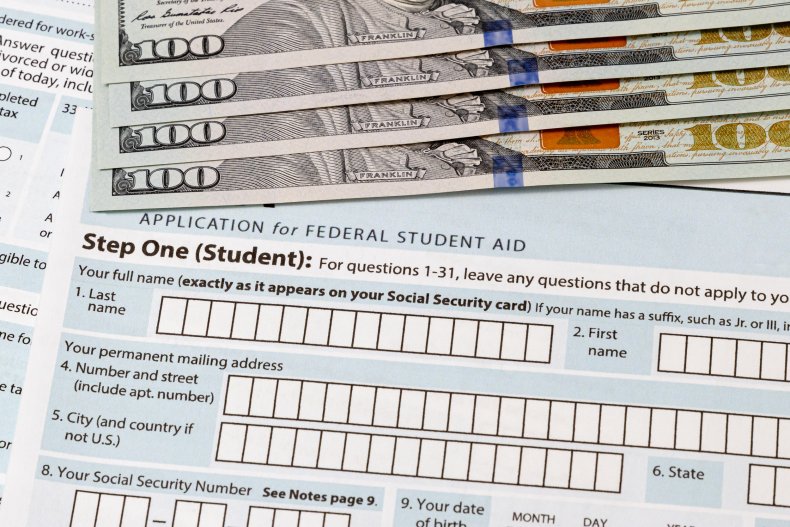Imagine having your dream house, a car and an advanced university education that’s led you to a six-figure income—does that really mean anything if you’re hundreds of thousands of dollars in debt?
This is a question many millennials, who are piling on debt at record levels, may be facing.
The demographic group—people currently aged between 27 and 42—makes up about 72.2 million of the U.S. population and is carrying “unprecedented levels of debt,” financial education expert Trinity Owen told Newsweek.
iStock / Getty Images Plus
One millennial couple in Washington, D.C., who have a combined household income of about $230,000, was reported to be just under “a million dollars in debt,” one of the partners revealed to finance expert Dave Ramsey during a radio broadcast in early April 2023.
The millennial debt crisis extends beyond the U.S. Over in Canada, 31-year-old Kyle Bauder, who lives in St. Albert, Alberta, told Newsweek that he’s nearly C$90,000 ($68,200) in debt. This entails C$50,000 in student loans after pursuing two university degrees and C$35,000 for a car loan. He now works as a delivery driver for Amazon.
Personal finance expert and CPA (certified public accountant) Alex King, a former vice president at Barclays Bank, is a 34-year-old millennial based in east London in the U.K. He told Newsweek he began his working life with over £27,000 (around $34,000) of student loan debt, which took him almost a decade to pay off.
As of the final quarter of 2022, Americans in their 30s had amassed nearly $4 trillion in debt, according to data from the Federal Reserve Bank of New York.
This is a 27 percent increase in debt since 2019—the largest rise of any age group—and reportedly the fastest this group has accumulated debt since the 2008 financial crisis.
So, how did this generation get to this point, and what can be done about it now? Newsweek spoke to experts to find out.
‘Skyrocketing’ Student Loan Debt
The causes behind millennial debt are “complex and multi-faceted,” but “skyrocketing” student loan debt is “a major contributing factor,” said Owen, who founded advice website The Pay at Home Parent.
Bauder agreed, explaining: “It’s really hard to get a good job without a degree, unless you pursue the trades, which a lot of us were convinced wasn’t a good idea. Nowadays a degree is a minimum barrier to entry for a lot of jobs, like having a high-school diploma was for my parents’ generation.”
According to a May 2023 report from the U.S. Federal Reserve, the total amount owed in student loans (including both federal and private loans) has hit just over $1.78 trillion.
Much of the millennial generation weren’t able to recognize what the cost of education would be and what jobs would be available to them once they graduated from school, Cara Macksoud, a certified financial behavior specialist and CEO of the financial assessment provider Money Habitudes, told Newsweek.
A lot of them had “prolonged the value of learning” and went for multiple degrees, so they weren’t earning, she said.
Bauder said he decided to go back to school in 2016 for computer science and did a few more years of studying. But “due to some mental health issues I wasn’t able to keep up with programming and only worked briefly in that field,” he said. Bauder was a programmer for a few months before working as an Amazon delivery driver.
Looking back, Bauder said he regrets going back to university for computer science, noting he should have either self-studied or taken a boot camp course instead.
Macksoud warned: “Time is money’s biggest asset, and the more time goes by, the older you get, the greater your expenses, and without earning, now you’ve compounded that with debt from student loans. That’s really a tremendous problem.”

iStock / Getty Images Plus
‘Rapidly Rising’ Cost of Living
The millennial burden of debt has been made heavier by the continued surge in living costs.
Peter Earle, an economist and research faculty member at the American Institute for Economic Research, told Newsweek that millennials have “lived in an era characterized by a rapid debasement of the dollar’s purchasing power, meaning rapidly rising costs of living.”
Having to “confront higher comparative prices than their boomer parents [those born roughly anywhere from 1946 to 1964] did has led many to incur debt to meet those implicit spending expectations.”
Last summer, the Consumer Price Index (CPI) saw its largest increase in 40 years with a 9.1 percent rise over a 12-month period ending in June 2022, driven largely by fuel and gas price hikes.
While gas and food prices eased in March, core inflation, which doesn’t include volatile food and energy costs, remains high. Core inflation surged 5.5 percent over the past year, according to a May 2023 report by the U.S. Bureau of Labor Statistics.
In a bid to help curb inflation, the Federal Reserve raised its interest rate to the 5 to 5.25 percent range in early May, marking its highest rate in 16 years. This would translate to higher interest rates for mortgages, car and business loans, and credit cards.

iStock / Getty Images Plus
‘Image-Driven’ Spending
There is also a “cultural shift” taking place at the moment, “where instant gratification and consumerism are prioritized over long-term financial planning,” Owen said.
Sean K. August, the CEO of The August Wealth Management Group in New York, told Newsweek: “Millennials tend to overspend on non-essential items, take on high-interest loans without fully understanding the terms, and fail to prioritize debt repayment.”
In a May 2016 survey by McKinsey & Company, a global management consulting firm, more than a third (38 percent) of millennials were reported to be “image-driven” consumers. This includes “higher-income showcasers” who follow the latest trends to show off their purchases on social media.
This comes as no surprise because millennials are a generation of “digital natives” who are “constantly connected,” Joseph Liu, a career change consultant and host of the Career Relaunch podcast, previously told Newsweek.

iStock / Getty Images Plus
‘Credit Cards Are Evil Tools’
The time that millennials spend in the digital world has naturally impacted their spending habits, with more young people preferring to shop online, which entails higher credit card spending.
Certified financial planner (CFP) Lawrence Sprung, the author of Financial Planning Made Personal, told Newsweek: “Credit cards are evil tools…no charge should go on a card that cannot be paid for by the time the bill hits your inbox.”
Earle said millennials have grown up in “an era of deepening financialization,” where credit is now associated with an even greater, vast array of goods and services than existed during the 1950s, 1960s and 1970s.
“That not only means that there are more ways to incur debt, but also that the assumption of debt has been normalized,” the economist explained.
King said millennials’ purchasing preferences and the soaring cost of living has led many into “a vicious cycle of taking on more debt.” Many were “forced” to rely on credit cards and loans to meet their needs, adding to their “crippling debt pile.”

iStock / Getty Images Plus
‘Americans Are Disappointingly Ignorant of Basic Finance’
According to 2018 research from the Global Financial Literacy Excellence Center (GFLEC), less than half (44 percent) of millennials in the U.S. were found to be “financially literate.”
Macksoud said millennials were not made aware—by their parents or whoever raised them—of the correlation between spendings and earnings. “Things come with costs, and that does separate who can afford things and who can’t.”
Earle said: “For a nation whose prosperity is as dependent upon markets and sound commercial practices as the United States is, Americans are disappointingly ignorant of basic finance and economics.”
Most millennials were never taught that “interest rates cannot stay at essentially zero levels forever.” Few have also had the concept that “savings are required to weather shifts in economic circumstances, changes in employment, and other inevitable uncertainties” drilled into them, Earle said.
Why Are Millennials So Financially Illiterate?
A 2019 survey by the GFLEC found that the vast majority (92 percent) of millennials would like to “increase their money management skills” and 83 percent are “widely aware” of the financial education resources available to them online for free.
But the “distrust of online resources and the perception that quality resources come with a price tag,” are what may be discouraging them from making use of these resources, the survey found.
Financial planner Vincent Gross, the founder of Pascack Capital, a registered investment advisory firm based in New Jersey, told Newsweek: “We can blame student loans, increased credit card usage, and cost of living, but at the end of the day what we see is a lack of financial education.
“If we expect teenagers to sign a document [for college education] that will put them into severe debt for decades to come, we should be equipping them with adequate knowledge to make an informed financial decision,” Gross said.
The Problem Could ‘Get Worse’
The impact that the burden of millennials’ debt can have on future generations is “a huge concern,” said Sprung.
The CFP warned that as many millennials begin to create families of their own, “it will be important to have a handle on their financial situation and debt, so they can impart good habits to the next generation. Without this, we should only expect this problem to continue, if not get worse.”
August said the economic impact of other factors, such as automation and globalization, may also limit job opportunities and exacerbate income inequality.
“These factors, combined with other challenges such as rising healthcare costs and the burden of debt, could contribute to financial hardship for the next generation,” he said.
King also noted that the debt struggle is expected to continue with younger generations, particularly given the rise of new types of credit, such as Buy Now Pay Later (BNPL) offers. These are “point of sale credit plans to fund even the smallest purchases, such as a pizza delivery,” he said.

iStock / Getty Images Plus
The Impact Has Already Begun
Charlotte Principato is a financial services analyst at Morning Consult, a global decision intelligence company based in the U.S. She told Newsweek that Generation Z is already facing its own challenges, including inflation and high student loan debt, as they establish their financial footing.
The analyst said: “They’re certainly worried about their financial futures,” according to the latest poll by Morning Consult in April 2023. The poll found that 44 percent of Gen Z adults say they believe that “they’ll never have the things they want in life because of their money situation.”
Macksoud said: “I think the pendulum has started to swing the other way,” noting that more of the younger generation are going to technical schools or heading straight into the workforce. “By not taking on that tremendous student loan debt, this new group has set itself apart.”
What Can Be Done Now?
While the damage might be done, experts say it’s not too late for millennials and younger generations to start making smarter choices.
Commit to Stop Adding to Your Debt
Sprung said: “You need to get a handle on the debt you currently have and make a commitment to stop adding to it.”
Evaluate your budget and see what funds are available to start chipping away at the debt that comes with the highest interest first until it is eliminated.
The certified financial planner advised: “You can also look for ways to consolidate the debt at lower interest rates, if available, to knock the debt down quicker.”
Sprung said “eliminating the debt is one thing, and having good habits in place so it does not happen again is another.”
Don’t Forget to Save While Paying Off Your Debt
One of the biggest mistakes people make when trying to pay down debt is to put all their funds towards “shrinking their balance while sacrificing savings,” consumer and money-saving expert Andrea Woroch told Newsweek.
The consumer expert explained that although you won’t make more money in interest on a savings account than what you end up paying in interest to carry a balance on your credit card, “saving gives you a cash cushion to carry you through a tough financial time,” such as an unexpected bill or an emergency expense, “without having to dip back into your credit card.”
Woroch also advised taking advantage of rising interest rates and letting your savings “grow effortlessly” by opening “a high-yield online savings account.”
For example, a Bread Savings high-yield savings account has one of the most competitive rates of 4.5 percent APY (annual percentage yield) at the moment, the consumer expert said.

iStock / Getty Images Plus
